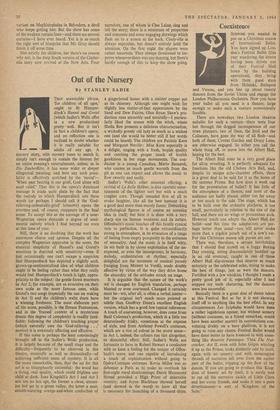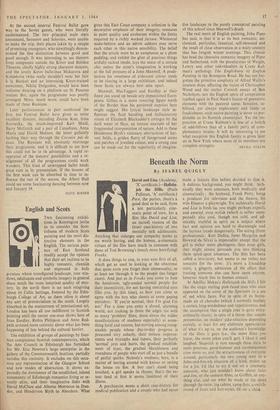Coexistence
SUPPOSE you wanted to
put on a Christmas season of International Ballet.
You have signed up Lon- don's Festival Ballet (this year wandering the streets having been driven out of their Festival Hall home by the building operations), they bring
dancers from the Soviet Union and engage the London Philharmonic Orchestra. Now you have your ballet all you need is a theatre, large enough to make such a venture economically feasible.
There are nowadays two London theatres suitable for such a venture—there were four but through the dogged incompetence of our town planners, two of them, the Stoll and the Coliseum, have gone the way of all flesh—and both of these, Covent Garden and Drury Lane, are otherwise engaged. So either you call the whole thing off, or move into the Albert Hall, hoping for the best.
The Albert Hall must be a very good place for all-in wrestling. It is perfectly adequate for functions like the old Chelsea Arts Ball, and, despite its unique echo-chamber effects, there is a great deal to be said for it as the home of the summer Proms. But how does it work out for the presentation of ballet? It has little of the atmosphere of a theatre, and most of the audience are badly placed, either too far away
or too much to the side. The stage, which has to be built over the orchestra platform, is too
small, particularly in relation to the size of the hall, and there are no wings or proscenium arch. However much one adapts the Albert Hall for ballet—and this time the adaptations are per- haps better than usual—you will never make more than a pigskin pouch out of a sow's ear. For this Christmas season silk purses are out.
There was, therefore, a certain inevitability that I should find myself on a foggy Boxing Day evening, sitting disconsolately huddled up in an old overcoat, caught in one of those Albert Hall slip-streams that deserve as much notoriety as the celebrated echo, trying to make
the best of things, just as were the dancers. Fortified with a few whiskies, I thought I made a
pretty good job of it, especially after I had stopped my teeth chattering, but the dancers were less successful.
Basically there is a great deal of dance talent at this Festival. But so far it is not showing
itself off to anything like the best effect. In any circumstances Les Sylphides would have been a rather lugubrious opener, but without scenery (without costumes, as a friend remarked, would have been another matter) its convolutions con- voluting drably on a bare platform, it is not going to raise any cheers. Festival Ballet would have done better to have bounced in with some- thing like Bourree Fantasque. Then The Nut- cracker, Act II, even with John Gilpin whirling it up as the Prince, looks distinctly odd by itself, again with no scenery and with meaningless threads of narrative left over from the earlier part of the ballet, tripping up the flow of the dances. If you are going to produce this 'King- dom of Sweets' act by itself, it is surely best to cut all the narrative cackle of Little Clara and her corny friends, and make it into a pure divertissement—a sort of `Kingdom of the Suite.'
At the second interval Festival Ballet gave way to the Soviet guests, who were literally undermanned. The two principal male stars announced, Semenov and Soloviev, were unable to make the trip, their places taken by a couple of promising youngsters, who unwittingly demon- strated the fine distinction between good and good enough. It was interesting to see dancers from companies outside the Kirov and Bolshoi Theatres, chiefly highly strung character dancers, and the lovely Kirov ballerinas Makarova and Kolpakova (who really shouldn't wear her hair a la Bardot) and an interesting Kirov-trained newcomer, Nikita Dolgushin, would have been welcome dancing on a platform on St. Pancras station. But, again the programme was poorly arranged. More, much more, could have been made of these Russians.
Later performances in part confirmed the first, but Festival Ballet have given us some excellent dancers, including Zsuzsa Kun, Irina Borowska, the much-improved Karl Musil, Barry McGrath and a pair of Canadians, Anna Marie and David Holmes, the latter gallantly bashing their way through the Corsaire pas de deux. The Russians will obviously rearrange their programme, and it is difficult to see how this could not be to its advantage. A rapid re- appraisal of the dancers' possibilities and a re- alignment of all the programmes could work wonders. This kind of unwrapped ballet needs great care in its presentation. If the lessons of the first week can be absorbed in time to in- fluence the rest of the season, the Albert Hall could see some fascinating dancing between now and January 19.
CLIVE BARNES































 Previous page
Previous page